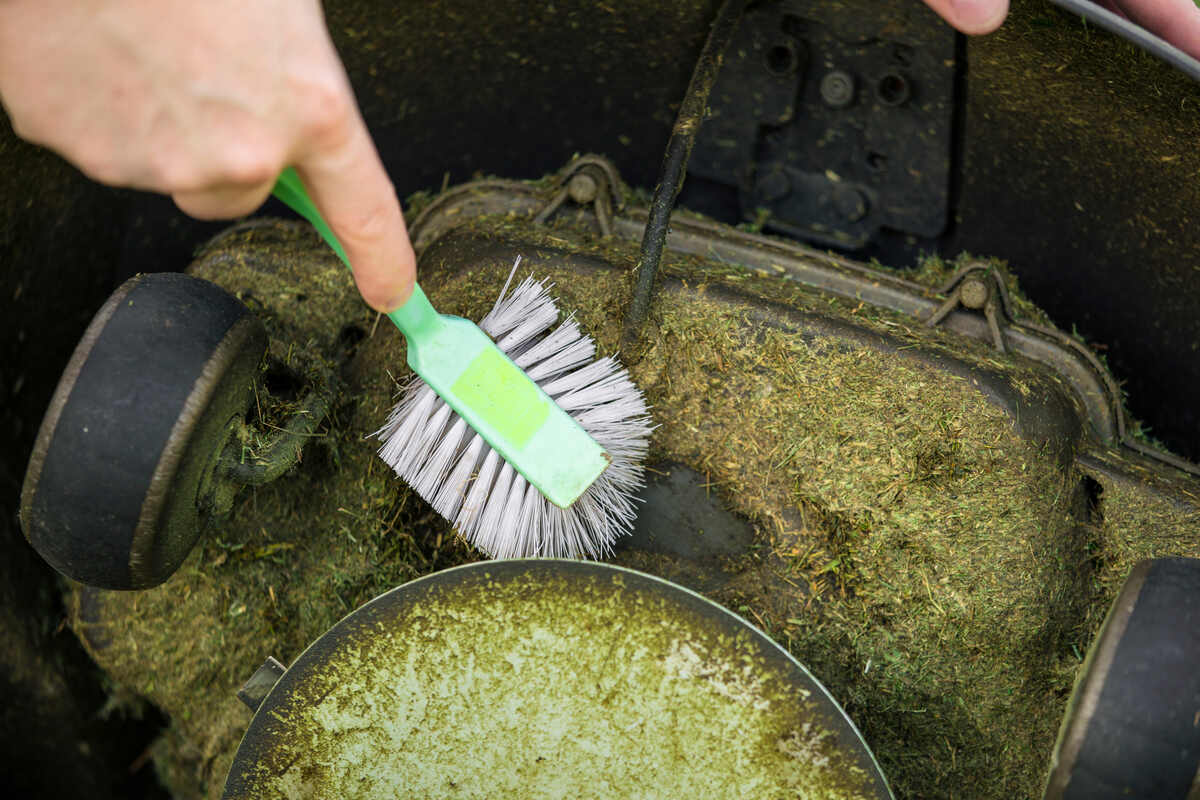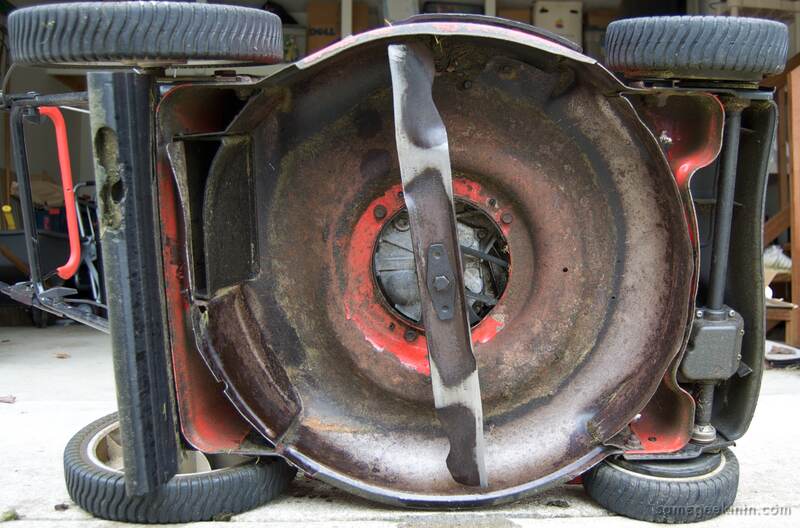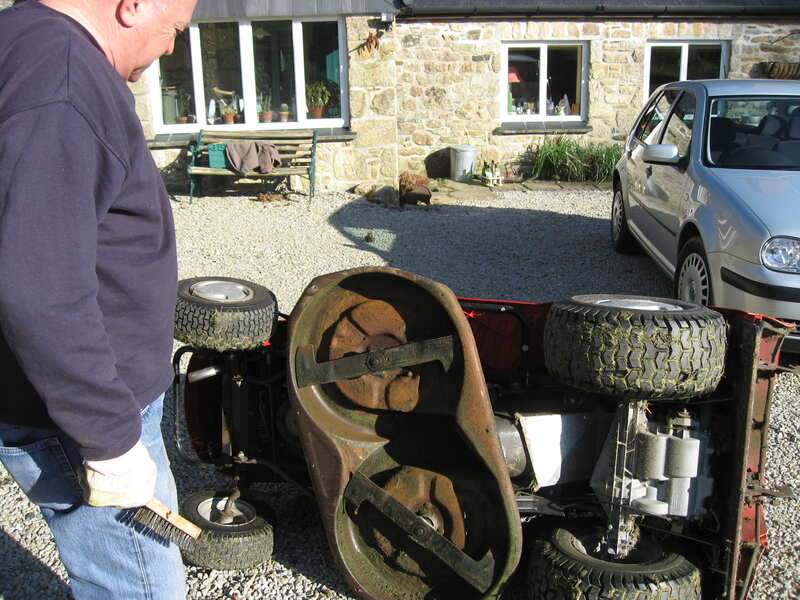
Cleaning the mower deck after each use is important if you want your lawn to look great and for your mower to perform well and last longer.
The best ways to clean your lawn mower deck are rinsing it with a hose, using the wash port, or cleaning the underside by hand.
Why Cleaning Your Lawn Mower Deck Matters
Cleaning the underside of your mower is an important part of lawn mower maintenance. After each use, the underside of your mower collects a substantial amount of dirt, grass clippings, and moisture. If left to dry, this dense, matted buildup can cause several issues that affect the mower’s performance:
- Reduced airflow: A clogged lawn mower deck can make it difficult for the air to circulate properly, and your mower’s carburetor can overheat, undermining its performance.
- Moisture and rust: Grass clippings provide an ideal breeding environment for moisture and rust. Rust is the kryptonite of your mower’s lifespan. It can cause corrosion of crucial parts and reduce the reliability of your mower over time.
- Fungal diseases: The dirty, congested underside of the mower also welcomes fungal or other common lawn diseases, which your mower then spreads to your lawn.
- Cutting quality: A clogged deck can also cause uneven cuts, leaving you with streaking patterns on your lawn.
So, what can you do to prevent these issues? Make it a habit to clean the underside of your mower after each use. If you simply don’t have time to maintain a lawn mower, hire a local lawn care pro to cut your grass instead.
Pro Tip: If you notice overheating or other airflow-related issues that are not caused by a clogged mower, you can also check the air filter. See our guide on How to Clean and Change a Lawn Mower Air Filter to learn more.
What You’ll Need to Clean Your Mower Deck

You will need the following items to clean the underside of your lawn mower:
- Garden hose
- Plastic scraper or putty knife
- Jack stand
- Compressed air (optional but highly effective)
- A rag and lubricating oil
- Ratchet or wrench (if you remove the mower blades)
- Safety gear (gloves and goggles)
Prepare Your Mower
Safety comes first, so before you get your hands dirty, prepare your mower:
- Place the mower on a flat surface, such as your garage floor or driveway, depending on the method you’re using.
- For gas-powered lawn mowers: Disconnect the spark plug wire if you’re cleaning the deck by hand.
- For electric lawn mowers: Remove the battery or ensure the cord is unplugged to keep the lawn mower from starting while you’re cleaning it. (For electric mowers, cleaning by hand is the only option.)
- Access the deck. Tilt the mower on its side with the carburetor or air filter facing up to prevent the carburetor from flooding. You can also tilt it up/back, using a jack stand to hold it in place. On some mowers, you can remove the deck altogether.
Side Note: Although you won’t need to do this every time you clean your mower, take this opportunity to inspect the blades for any damage or dullness. A sharp blade is vital for a clean cut, so sharpen the lawn mower blades once or twice a season.
See Related: How Often Should You Sharpen Lawn Mower Blades?
How to Clean a Mower Deck: 3 Ways

Now that you’ve gathered your tools and prepared the mower, let’s learn how to clean the underside of your lawn mower deck to improve its cutting performance and prolong the life of your mower.
Rinse With a Hose
Gas models only
Use your garden hose to wash away the big chunks of dirt and grass build-up you see on the underside of the deck. You can also use a degreaser if you feel you have stubborn build-up.
After washing away the dirt, you can leave the mower to dry on its own or you can speed up the process using a dry cloth or a leaf blower.
Pro Tip: Once the deck is completely dry, use silicone lubricant spray to add a layer of protection against rust and corrosion. If you need to improvise, cooking spray will do the trick. You can also protect your deck by adding another coat of enamel paint that covers the deck and helps prevent grass from sticking to it.
If you removed the blade or the deck to clean the mower, now it is time to reassemble it:
- Reattaching the blades: Locate the spindle on the mower’s underside and align the holes in the blade with it. Place the blade on the spindle and secure it with the nut or bolt you removed before. Tighten it securely, but be careful not to overtighten it since this can harm the blade or spindle.
- Reassemble the deck: Follow the manufacturer’s directions for deck reattachment, ensuring all brackets and pins are in the correct positions.
Now that you’re done cleaning and everything is back in place, it’s safe to reconnect the spark plug wire. Start the mower and let it run for a few minutes to confirm everything works properly. Watch out for strange noises or vibrations that may signal something was put back incorrectly.
Use the Deck Wash Port
Gas models only
Many push and riding mowers have a deck wash port where you can simply attach a hose to clean the deck. Keep in mind this method won’t give the deck a thorough clean, but it can do the trick for a fast cleanup in between mows. Here’s how to use the wash port:
- Place the mower in your driveway. Make sure it’s turned off. Remove the grass catcher bag.
- Attach your garden hose to the port, which is located on the top of the deck.
- Turn on the water and then start the mower.
- Lower the deck to your lowest cutting height.
- Engage the blade for a minute or so until you see no more dirt or clippings coming out.
- Turn off the engine. Next, turn off the water. Disconnect the hose, and raise the deck again so it can dry properly. You can also run the engine again, engaging the blade for a minute or two to help the deck dry.
Clean by Hand

Gas or electric models
Now, let’s learn how to clean your mower deck one final way. Time to get your hands dirty:
- First, use a broom, dish scrubber, scrub brush, or piece of cloth to remove loose debris, dirt, and dried grass clippings from under the deck. Compressed air is especially helpful in removing dry residue and grass clippings from small crevices.
- Next, use a mower deck scraper (or a putty knife or ice scraper) to gently scrape away the remaining debris. Prefer tools made of plastic so they won’t scratch the deck’s surface, which can lead to rust. To avoid damaging the deck, begin in the center and work your way outward.
Pro Tip: Remember to wear protective eyewear for this stage since debris will be flying all over the place.
If you notice rust, don’t be alarmed. There are efficient methods for dealing with it:
- Scrape away loose rust with a wire brush.
- Use a silicone spray or a thin oil coating to help build a moisture-resistant barrier.
- Apply a rust converter or rust-resistant paint. Just make sure you follow the manufacturer’s recommendations when applying these products.
Tips on How to Keep Your Mower Deck Cleaner Longer
While cleaning your mower regularly is a necessity, there are some things you can include in your routine to keep the deck cleaner for longer:
- Mow only when the grass is dry. Wet grass is more likely to stick to your mower’s blades and deck. It’s generally best to mow when the grass is dry to prevent clumping and achieve a cleaner cut. Wet grass can clog the mower deck and lead to uneven cutting. For more lawn mowing tips, check out our complete guide to how to mow a lawn.
- Mow regularly. Longer grass blades are more prone to tangling and getting stuck in your mower blades. By mowing regularly, you avoid this problem. If for some reason you left your grass to grow tall, raise the mowing height as well.
- Consider high-lift blades. High-lift blades help improve the airflow and reduce the amount of debris that gets caught in the blades and deck.
- Keep the paint in check. The enamel coat of paint that covers the underdeck helps prevent grass from sticking to it, but it usually wears off over time. So adding another coat of paint can help reduce the debris build-up under your mower.
- Use a lubricant. A silicone lubricant spray can also help keep your mower deck cleaner for longer. The lubricant acts as a coat protecting the deck from the grass build-up clinging to the machine.
Pro Tip: To make your mower last as long as possible, follow a seasonal lawn mower maintenance plan that includes regular maintenance practices that can increase your mower’s lifespan.
FAQ About Cleaning Lawn Mowers
Cleaning the underside of your lawn mower is an integral part of routine maintenance, and the timing of this activity depends on your mower’s usage and the grass-cutting season. Generally, cleaning it after every use is best, especially in damp environments. But experts suggest cleaning at least twice a year.
The best times to clean your mower’s deck are as follows:
• After each use (preferred): Ideally, you should clean the underside of your lawn mower after each use. This approach prevents grass clippings, dirt, and moisture from accumulating and hardening on the deck, which can cause corrosion, decreased cutting performance, and even damage the mower over time.
• End of the mowing season: If you use your lawn mower seasonally and intend to store it for a lengthy period, you at least must thoroughly clean the underside at the end of the season when you winterize your mower. It prevents rust and damage by ensuring no residue or debris remains on the mower during the off-season.
• Alongside other maintenance tasks: If you intend to do lawn mower maintenance such as blade sharpening or air filter replacement, it’s a good idea to clean the underside, too. Cleaning improves visibility and access to vital components while keeping dirt out of sensitive areas during maintenance.
• Decrease in performance: If your lawn mower isn’t cutting as well as it used to, or if you have uneven cuts, it’s a sign that the underside needs to be cleaned.
Ideally, no. Although you might hear other homeowners saying they pressure wash their mower decks, pressure washing can cause water to enter the engine or other parts that aren’t supposed to get wet. Use one of the three methods above to clean the underside of the deck; use a leaf blower or compressed air to clean the top of the deck.
Yes, you can clean the mower deck without removing the blade. If you have a mower with a “deck wash” or “deck cleanout” feature, you can simply attach your garden hose to the port on top of the cutting deck, and the water will pass through a deck adapter to spray the mower’s underside.
You can also clean the deck by hand or with a hose and not remove the blade.
Ideally, you should avoid anything besides water and some mild soap to loosen the dirt. Other chemical products such as bleach can damage the paint, which helps protect your deck against rust.
Say Goodbye to Mower Cleaning and Hire a Pro Instead
When you have a busy life full of family, friends, work, and hobbies, keeping the lawn mower clean is easy to forget. It’s a good thing there are lawn care pros to help out. When you hire a local lawn care company to mow your lawn for you, you can cross mowing and mower maintenance off your list in one fell swoop — all while supporting a local small business.
Let LawnStarter connect you with the best lawn care pros in your area through our convenient online platform or mobile app, and kiss lawn mower cleaning goodbye forever.
Main Image Credit: FotoHelin / Adobe Stock Free / License